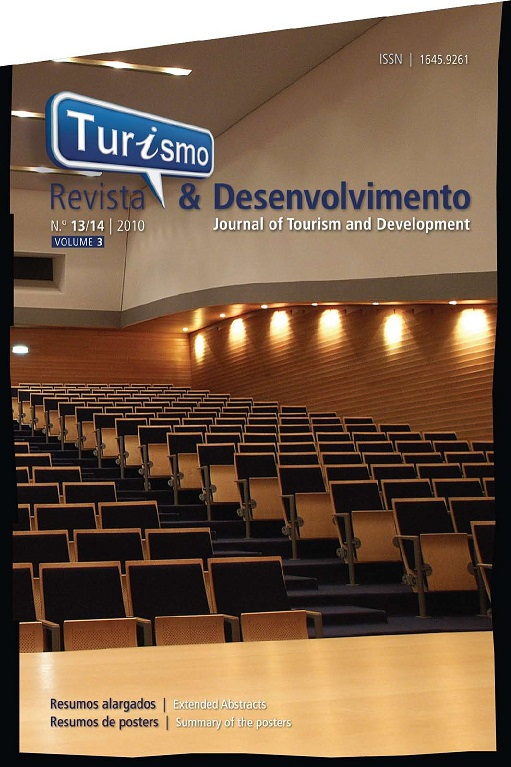Tourists’ experience: capture the dark side of the moon
Resumo
Objectives | Regardless of the richness and intensity, the tourist experience in a destination is rarely 100% perfect or rewarding. At the best, there are always small details or remarks aimed to improve some aspects of that experience to make it even better. Most of the research focuses on visitors’ experiential dimensions, which tend to be evaluated as intrinsically positive. Topics such as destination image, satisfaction and tourism service research generally convey a constructive and affirmative position of the destination (Beerli and Martin, 2004; Chon, 1992). The emphasis is oriented to the consequences of “good” relationship between brand destination and visitor or customer whose outcome is loyalty or recommendation. In opposition with retailing research (Anderson, 1973; Day et al., 1981; Kelly et al., 1993; Mano, 1999; Singh, 1990), there are very few studies looking at dark side of the tourist experience (Kotler et al., 2003). Our study converges on the problems, critical situation or just annoying aspects a tourist faces during his/her daily interaction with the new environment. We aim to propose a typology of dissatisfying contexts. Then we will analyse their nature and scope in terms of merely cultural perspectives and differences or in the other extreme wrongdoing and harmful behaviour.We are particularly interested to assess the overall visitor experience in their immersion condition with natives – how visitors feel and evaluate their habits,sociological structures, psycho-cultural specificities. Such requirement implies some meaningful involvement with the community and participation in their activities.
Methodology | The collection of data process is based on the use of qualitative techniques such as semi-structured depth interviews and focus group. We targeted Erasmus students in the first two months of their living in the country. The choice of this population portrays some advantages: they are temporary visitors – maximum four months - and according to the definition of WTO they could be labelled as tourists, their homogeneity in terms of age, interests, educational status, and involvement in local activities allow us to capture how they evaluate the cultural specificities and its impact on their interpretation of events. The fact of living and being integrated in a new community makes easier the learning process of a new social context, the understanding and elaboration of attitudes regarding the destination which is simultaneously their new, still temporary, home. Qualitative techniques: The interaction between focus group participants is enhanced and expressions of people’s experiences, feelings, opinions, wishes,views and concerns are encouraged. This method allows a researcher “to see reality from a client’s point of view” (Krueger, 1994:9). Accomplishing a dozen previous interviews are useful to draw a general picture of personal and rather intimate motivational dimensions. The outcome of that first step will help to design the focus group research instrument. Then four focus group will follow. Each group include eight to ten participants.
Main results and contributions | Preliminary results: The semi-structured depth interviews have been accomplished yet. We learn that the Spanish and Brazilian should be analysed separately from the rest of other nationalities. Among them the perspectives of the Galegos fall apart from the rest of Spaniards. The following description can not be labelled as “results” rather they are a sample of examples which will be further considered and assembled in the typology process: There are some Portuguese habits, which have not been categorised as annoying but at least rather weird thus sometimes enigmatic or even a little bumpy. This is the case of women seen washing their front door steps including some part of the street area. The informal manners used by old ladies such as “menina” sounds nonsense for the some German visitors but sensitive and caring for Latin people. Especially for Nordic students the punctuality or lack of it is a sad trait of the Portuguese – starting with public transports. The urban configuration where the old and new mix together turns some villages uncharacteristic. The dirty facet and careless of some streets, squares and gardens was also remarked. The rudeness of some authorities – eg. passengers’ control at the airport – or the bluntly behaviour in some restaurants also upsets our visitors.
Limitations | The age range of the population under analysis 20 to 28 years old.All of them are students. They do not consume some of the managerial relevant tourist. Their accommodations are not hotels and they do not have to explore so intensively and under a time restrain the popular tourist sites as the excursionists or the short-time visitors usually do. They do have plenty of time to visit those places during their leisure time. Therefore the service failures and other managerially relevant aspects concerning the companies devoted to the hospitality business can hardly be analysed. This is a qualitative research thus we are unable to measure in what extent those categories are typical or expressive.
Conclusions | At this point in time and due to this extended abstract is based on research in progress we can only report an incomplete picture of the results. However, at the best of our knowledge this study is the first to systematically analyse consumer dissatisfaction and complaining in the tourism business with particular focus on evaluation of socio-cultural aspects. Not all negative experiences and critical situations portray managerial relevance but they all show meaningful aspects that should be taken into consideration if we want to improve our hospitality.





